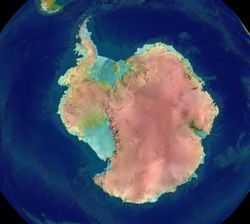Geography of Antarctica
| Geography of Antarctica | |
|---|---|
 | |
| Continent | Antarctica |
| Coordinates | 80°S 90°E / 80°S 90°E |
| Area | Ranked 2nd (unofficially) |
| • Total | 14,000,000 km2 (5,400,000 sq mi) |
| • Land | 100% |
| • Water | 0% |
| Coastline | 17,968 km (11,165 mi) |
| Borders | No land boundaries |
| Highest point | Vinson Massif, 4,897 m (16,066 ft) |
| Lowest point | Bentley Subglacial Trench, −2,555 m (−8,382.5 ft) |
| Longest river | Onyx River, 25 km |
| Largest lake | Lake Vostok, 26,000 sq m (est.) |
| Climate | subarctic to arctic |
| Terrain | ice and barren rock |
| Natural Resources | krill, fin fish, crab |
| Natural Hazards | high winds, blizzards, cyclonic storms, volcanism |
| Environmental Issues | depleting ozone layer, rising sea level |
The geography of Antarctica is dominated by its south polar location and, thus, by ice. The Antarctic continent, located in the Earth's southern hemisphere, is centered asymmetrically around the South Pole and largely south of the Antarctic Circle. It is surrounded by the southern waters of the World Ocean – alternatively (depending on source), it is washed by the Southern (or Antarctic) Ocean or the southern Pacific, Atlantic, and Indian Oceans. It has an area of more than 14 million km².
Some 98% of Antarctica is covered by the Antarctic ice sheet, the world's largest ice sheet and also its largest reservoir of fresh water. Averaging at least 1.6 km thick, the ice is so massive that it has depressed the continental bedrock in some areas more than 2.5 km below sea level; subglacial lakes of liquid water also occur (e.g., Lake Vostok). Ice shelves and rises populate the ice sheet on the periphery. Only about 2% of the continent is not covered by ice.
Regions


Physically, Antarctica is divided in two by Transantarctic Mountains close to the neck between the Ross Sea and the Weddell Sea. Western Antarctica and Eastern Antarctica correspond roughly to the eastern and western hemispheres relative to the Greenwich meridian. This usage has been regarded as Eurocentric by some, and the alternative terms Lesser Antarctica and Greater Antarctica (respectively) are sometimes preferred.
Western Antarctica is covered by the West Antarctic Ice Sheet. There has been some concern about this ice sheet, because there is a small chance that it will collapse. If it does, ocean levels would rise by a few metres in a very short period of time.
Volcanoes
There are four volcanoes on the mainland of Antarctica that are considered to be active on the basis of observed fumarolic activity or "recent" tephra deposits: Mount Melbourne (2,730 m) (74°21'S., 164°42'E.), a stratovolcano; Mount Berlin (3,500 m) (76°03'S., 135°52'W.), a stratovolcano; Mount Kauffman (2,365 m) (75°37'S., 132°25'W.), a stratovolcano; and Mount Hampton (3,325 m) (76°29'S., 125°48'W.), a volcanic caldera.
Several volcanoes on offshore islands have records of historic activity. Mount Erebus (3,795 m), a stratovolcano on Ross Island with 10 known eruptions and 1 suspected eruption. On the opposite side of the continent, Deception Island (62°57'S., 60°38'W.), a volcanic caldera with 10 known and 4 suspected eruptions, have been the most active. Buckle Island in the Balleny Islands (66°50'S., 163°12'E.), Penguin Island (62°06'S., 57°54'W.), Paulet Island (63°35'S., 55°47'W.), and Lindenberg Island (64°55'S., 59°40'W.) are also considered to be active.
West Antarctica

%2C_Laubeuf_Fjord%2C_Webb_Island.JPG)
West Antarctica is the smaller part of the continent, divided into:
Areas
Seas
Ice shelfs
Larger ice shelfs are:
- Filchner-Ronne Ice Shelf
- Larsen Ice Shelf
- Abbot Ice Shelf
- Getz Ice Shelf
- Sulzberger Ice Shelf
- Ross Ice Shelf
For all ice shelfs see List of Antarctic ice shelves.
Islands
For a list of all Antarctic islands see List of Antarctic and sub-Antarctic islands.
East Antarctica

East Antarctica is the larger part of the continent, both the South Magnetic Pole and geographic South Pole are situated here. Divided into:
Areas
- Queen Maud Land with
- Wilhelm II Land
Seas
Ice shelfs
Larger ice shelfs are:
- Riiser-Larsen Ice Shelf
- Ekstrom Ice Shelf
- Amery Ice Shelf
- West Ice Shelf
- Shackleton Ice Shelf
- Voyeykov Ice Shelf
For all ice shelfs see List of Antarctic ice shelves.
Islands
For a list of all Antarctic islands see List of Antarctic and sub-Antarctic islands.
Research stations
Territorial landclaims
Seven nations have made official Territorial claims in Antarctica.
Dependences and territories
- Bouvet Island
- French Southern and Antarctic Lands
- Heard and McDonald Islands
- South Georgia and the South Sandwich Islands
- Peter I Island
See also
External links
- Political Claims Map
- USGS TerraWeb: Satellite Image Map of Antarctica
- United States Antarctic Resource Center (USARC)
- BEDMAP
- Antarctic Digital Database (Topographic data for Antarctica, including web map browser)
- Landsat Image Mosaic of Antarctica (LIMA; USGS web pages)
- Landsat Image Mosaic of Antarctica (LIMA; NASA web pages)
| |||||||||||||||||
| |||||||
